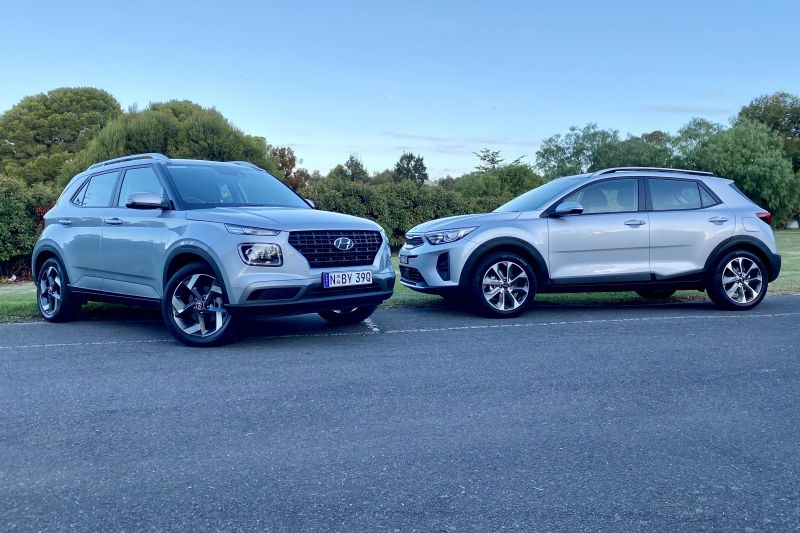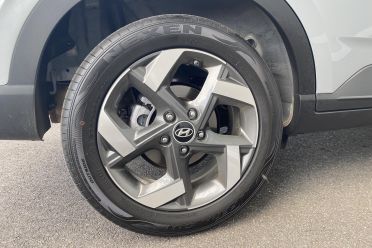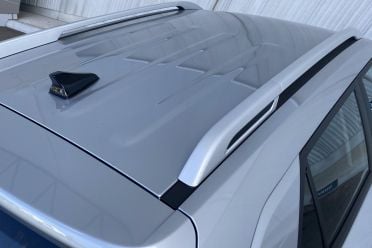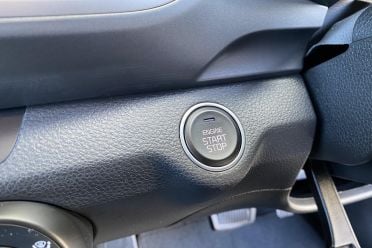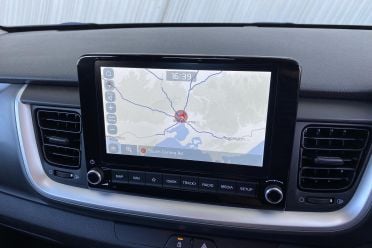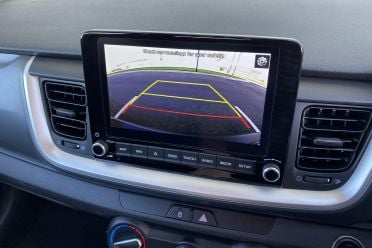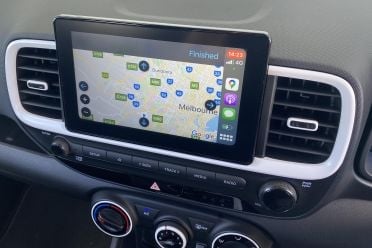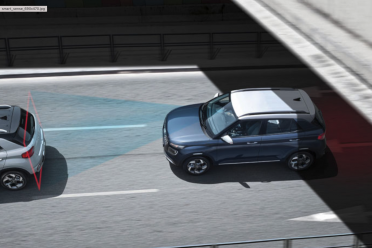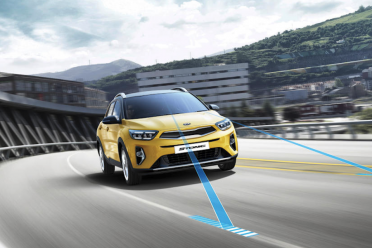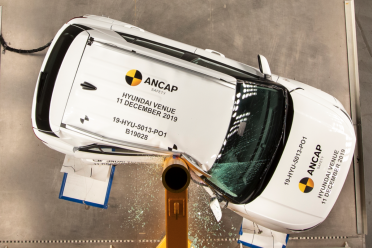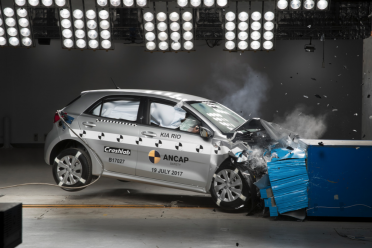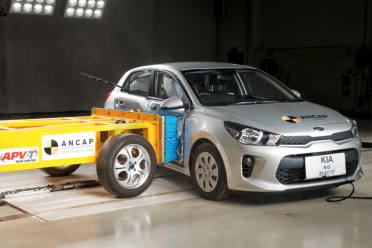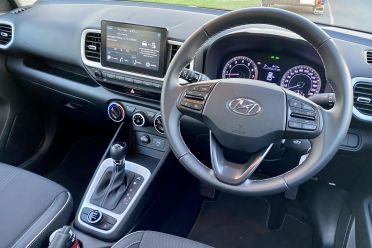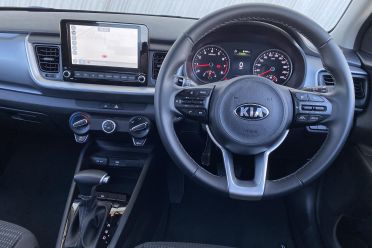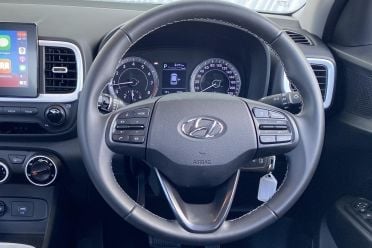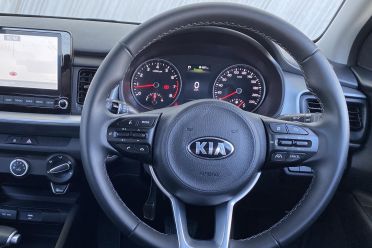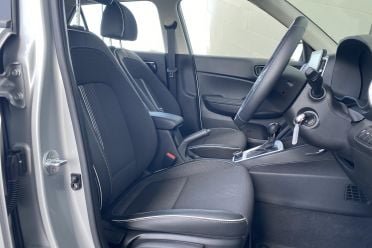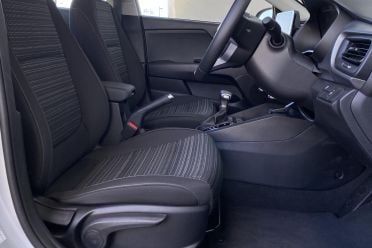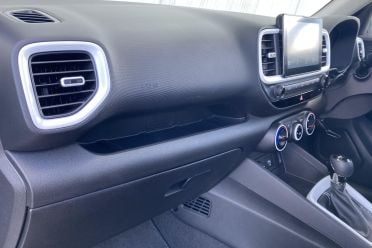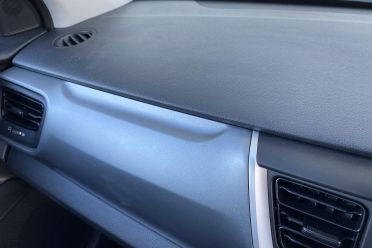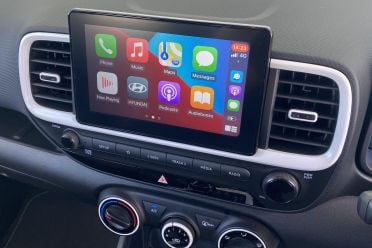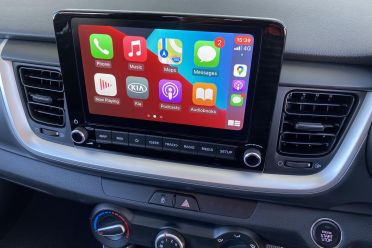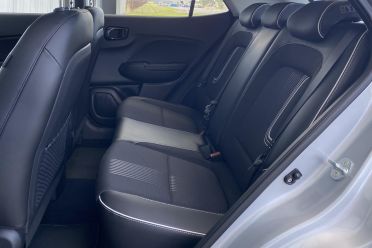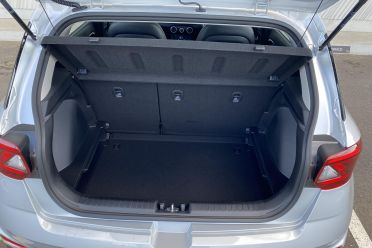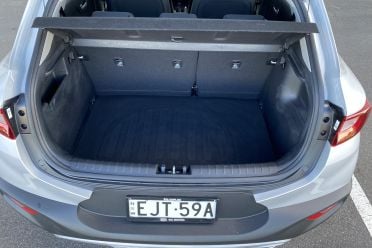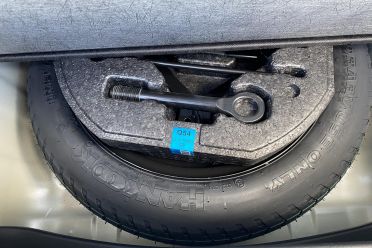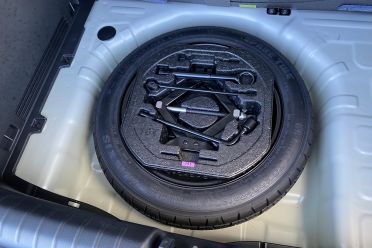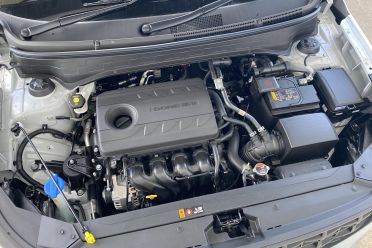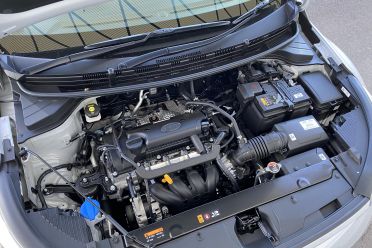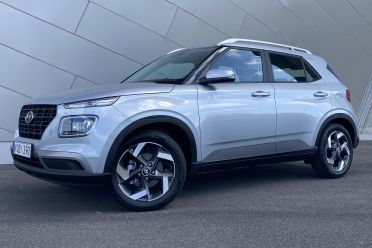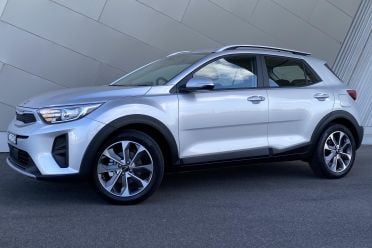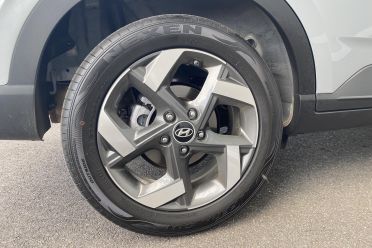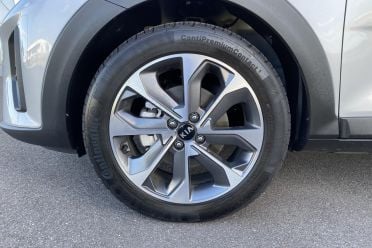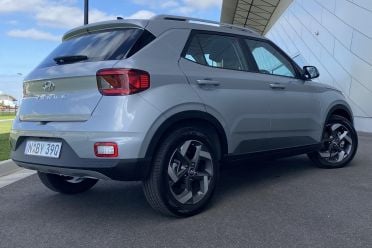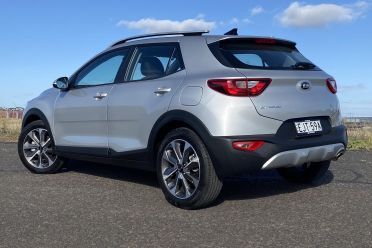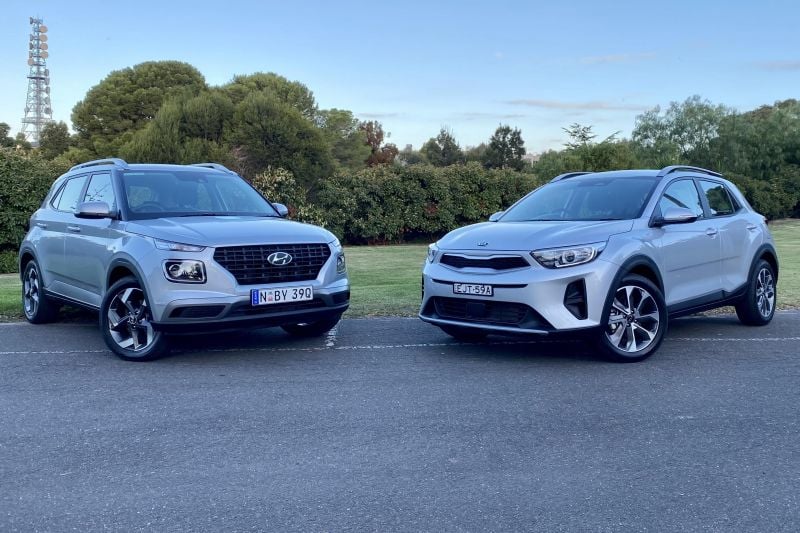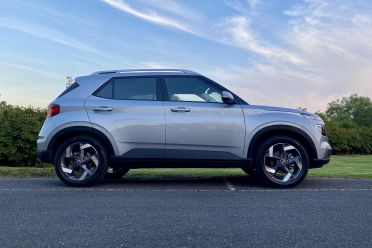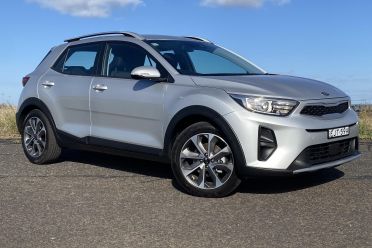Hyundai and Kia offer two related small crossover SUVs that very much tap into the current trend, respectively called Venue and Stonic.
Both have the footprint of a typical light-sized city car but offer more height and clearance, elevated driving positions, and rugged looks.
The Venue is now Hyundai’s smallest vehicle, and cheapest at base level. The Stonic is Kia’s entry SUV but mechanically related to the smaller and cheaper Rio.
Neither are as well known as their more impressive big ‘siblings’: the Hyundai Kona and Kia Seltos.
Which is the better option? And are you better off with a bigger but arguably blander, and certainly more commonplace, Hyundai i30 or Kia Cerato for similar money?
How much?
We’re testing mid-range specification models here, which best balance value-for-money and standard features.
You still pay a premium for the design and elevation of a crossover SUV, compared to a traditional light-sized hatchback.
The Hyundai Venue Active with automatic transmission has a price of $24,890 before on-road costs, which is equal to roughly $28,600 drive-away according to the brand’s website (State taxes slightly vary).
The Kia Stonic Sport wears a higher sticker price of $25,990 before on-road costs, but is actually cheaper on a drive-away basis at $26,490 thanks to an ongoing Kia offer.
The Hyundai Venue base model (the brand’s cheapest car) can be had for as little as $24,500 drive-away and the top-of-the-range Elite costs from $30,500.
A Stonic S base model can be had for $23,490 drive-away, and the turbocharged Kia Stonic GT-Line flagship is priced at $30,490.
Other offerings worth researching are the value-leading MG ZS, top-selling Mazda CX-3, and the conceptually similar Toyota Yaris Cross, Volkswagen T-Cross, Skoda Kamiq, Ford Puma, Nissan Juke, and Suzuki Vitara.
We’ll also note that a base i30 hatch ($27,490 drive-away with auto) and Kia Cerato hatch ($25,490 with auto) can and should be cross-shopped against this pair if and when you head to a dealer.
What do you get?
On the outside both have 17-inch alloy wheels with a space-saving temporary spare, halogen headlights (the flagship Stonic GT-Line has flasher LEDs), and roof rails.
The Hyundai alone at this spec grade has LED daytime running lights compared to halogens, but the Kia counters with exclusive proximity key auto unlocking as you approach the vehicle, and button-operated start.
| Hyundai Venue Active | Kia Stonic Sport | |
|---|---|---|
| Wheels | 17-inch alloy | 17-inch alloy |
| Spare wheel | Space saver | Space saver |
| Headlights | Dusk-sensing halogen | Dusk-sensing halogen |
| Daytime running lights | LED | Halogen |
| Key access | Key fob button | Proximity sensor |
| How to start | Twist key fob | Start button |
| Roof rails | Standard | Standard |
On the inside both the Hyundai and Kia come with manually-adjustable air conditioning, cloth seat trim, 8.0-inch touchscreen displays, Apple CarPlay and Android Auto, six-speaker audio systems, Bluetooth, and reversing cameras.
The difference in features really comes down to the head unit: again the Kia offers a little more than its Korean twin, with standard sat-nav and digital radio. However the Hyundai’s phone mirroring software (Apple/Android) are both wireless rather than wired.
| Hyundai Venue Active | Kia Stonic Sport | |
|---|---|---|
| Air conditioning | Manual | Manual |
| Seat trim | Cloth | Cloth |
| Touchscreen | 8.0-inch | 8.0-inch |
| Apple CarPlay | Wireless | Wired |
| Android Auto | Wireless | Wired |
| Satellite navigation | No | Standard |
| Speakers | Six | Six |
| Bluetooth | Standard | Standard |
| Digital radio | No | Standard |
| Camera view | Reverse | Reverse |
There are various interesting colours available on each.
The Hyundai’s base colour is Polar White, while Phantom Black, Cosmic Grey, Intense Blue, Denim, Fiery Red, and Typhoon Silver metallic and mica paints are all an extra $495. Only the Venue Elite grade can be ordered with two-tone.
The Kia’s base price is Clear White, while Aurora Black, Signal Red, Mighty Yellow, Sporty Blue, Silky Silver, and Perennial Grey metallic and pearlescent paint all cost an additional $520. Only the Stonic GT-Line grade has a two-tone option.
MORE: 2021 Hyundai Venue price and specs
MORE: 2021 Kia Stonic price and specs
Are they safe?
| Hyundai Venue Active | Kia Stonic Sport | |
|---|---|---|
| Front-on airbags | Standard | Standard |
| Front-side airbags | Standard | Standard |
| Two-row curtain airbags | Standard | Standard |
| AEB and collision alert | Camera | Camera and radar |
| Lane-keeping assist | Active | Active |
| Lane-centring assist | No | Standard |
| Blind-spot monitor | No (Elite grade only) | No |
| Rear cross-traffic alert | No (Elite grade only) | No |
| Cruise control | Passive | Passive |
The Hyundai Venue carries a four-star ANCAP crash rating with a 2019 date stamp.
It scored very well for adult occupant protection (91 per cent) and child occupant protection (81 per cent), but did less well for vulnerable road-user protection (62 per cent) and active safety assist (62 per cent).
Circuit testing found performances of the lane-keeping assist, pedestrian AEB, and interurban-speed AEB to be ‘adequate’ rather than ‘good’.
The Kia Stonic’s ANCAP crash score was in fact derived from the Rio’s crash test, such are their mechanical similarities.
It carries a five-star rating, however this is with an older, less-challenging 2017 date stamping focused on passive occupant protection.
This is an example of why its important to check ANCAP date stamps as well as star ratings.
What are they like inside?
The two cabins are very similar, with manually adjustable and height-adjustable (driver) seats with equivalent side bolstering.
Each has a leather-wrapped steering wheel with rake and telescopic reach adjustments, phone and audio buttons on the left spoke, and cruise control and menu controls on the right. Both have analogue instruments flanking a small TFT screen with digital speedo.
The aesthetic differences come down mostly to colour palette, with the Hyundai’s seats trimmed in lighter fabric and the dash inserts popping a little more brightly. The Hyundai Venue’s dashtop and door trims feel a little more premium as well, graded on a curve… Both are built to a price.
Each has manual A/C controls, and similar amounts of tunnel/glovebox/door storage. The Kia has a trick two-layer storage cubby below the vent controls whereas the Hyundai has a single open section plus another ahead of the front passenger.
The Kia offers a superior infotainment system thanks to standard satellite navigation and DAB+, and its wired Apple/Android streaming software worked flawlessly unlike the still-buggy wireless Hyundai head unit.
There’s not actually a great deal of difference in terms of rear space. The Hyundai offers 980mm of potential rear headroom, a maximum 870mm rear legroom, and 1365mm of rear shoulder room – 5mm/20mm/10mm more than the Kia.
I’m 194cm tall and had sufficient back seat space for short trips, but they’re best used regularly by adults 180cm or below for maximum comfort. The Venue sits slightly higher and its headroom felt superior, while its side windows seem to let in a smidgen more light.
Dimensionally the 4040mm long and 1592mm tall Hyundai Venue is 300mm shorter end-to-end overall than a Hyundai i30 hatch but also 140mm taller,. The 4140mm long and 1520mm tall Kia Stonic is 370mm shorter and 80mm taller than a Kia Cerato hatch.
The boots are about the same and they both have temporary spare wheels.
Dimensions:
| Hyundai Venue Active | Kia Stonic Sport | |
|---|---|---|
| Length | 4040mm | 4140mm |
| Width | 1770mm | 1760mm |
| Height | 1592mm | 1520mm |
| Wheelbase | 2520mm | 2580mm |
| Ground clearance | 170mm | 183mm |
| Cargo space | 355L | 352L |
What’s under the bonnet?
Neither car is overburdened with power and torque, reflecting their makers’ urban focus.
The Kia’s 1.4-litre naturally aspirated petrol engine pushes out 74kW of power and 133Nm of torque, driving the front wheels through a six-speed automatic transmission. The GT-Line range-topper gets a 1.0-litre turbo instead.
The Hyundai’s 1.6-litre naturally aspirated four makes 90kW and 151Nm, likewise driving the front wheels through a six-speed auto. This gives the Venue a superior power-to-weight ratio and a two-second faster dash to 100km/h by my testing compared to the Stonic.
Fuel economy is about the same in lab testing: 7.2L/100km for the Venue and 6.7L/100km for the Stonic.
| Hyundai Venue Active | Kia Stonic Sport | |
|---|---|---|
| Fuel type | 91 RON petrol | 91 RON |
| Displacement | 1.6-litre 4-cyl | 1.4-litre 4-cyl |
| Induction | Naturally aspirated | Naturally aspirated |
| Power | 90kW @ 6300rpm | 74kW @ 6000rpm |
| Torque | 151Nm @ 4850rpm | 133Nm @ 4000rpm |
| Power-to-weight | 75.1kW per tonne | 62.1kW per tonne |
| Fuel economy | 7.2L/100km | 6.7L/100km |
| 0-100km/h | Approx. 10.5 seconds | Approx. 12.5 seconds |
| Driven wheels | Front | Front |
| Transmission | 6-speed auto | 6-speed auto |
How do they drive?
Both the Hyundai Venue and Kia Stonic have MacPherson strut independent front suspension and simple torsion beam rear ends.
They also share a brake package comprising 280mm-diameter ventilated front discs and 262mm solid rear discs, as well as motor-assisted electric power steering with a 10.2m turning circle. The Kia has 13mm more clearance.
Both have suspension tuned in Australia by two different engineering teams, with the Kia feeling a little lower and dartier in corners with weightier steering, and the Venue sitting you up a little higher and seeming to round off sharp bumps a little better.
The Kia’s Continental tyre package is better than the Hyundai’s Nexo rubber, with more grip available and less road noise emitted. Both measured 71 decibels at 100km/h on my test road but it was the wind noise that was the same.
The engines are the major point of difference. Upon pressing the throttle in the Kia, there’s a fair bit of noise through the firewall (around 73dB average) but not a whole of get-up-and-go. There’s no lag and it tries its best, but a 12.5 second run to 100km/h is slow.
The Hyundai’s engine is no less thrashy or raucous than the Kia’s, but it has more grunt, even though it needs higher rpm to generate its peak outputs. It also has bespoke surface-dependent driving modes that change throttle calibration. My 0-100km/h run took 10.5sec.
Booth use basic torque-converter-style automatic transmissions that give you immediate response. Manual gearboxes are available for the perishing few who like to use a clutch themselves.
One side benefit of the basic multi-point injected four-pot engines are the fact they’ll both run on cheap 91 RON fuel.
Cost of ownership
All Hyundais get a five-year warranty whereas Kias come with seven years cover.
The Hyundai Venue has annual or 15,000km servicing intervals and the first five visits are capped at $259, $259, $339, $459, and $259 apiece. That’s $1575 all up, which you can pay-as-you-go or pay in advance at purchase time.
The Kia Stonic has the same annual or 15,000km intervals and the first seven visits are capped at $281, $467, $336, $702, $317, $600, and $336 apiece. That’s $2103 for the first five years, or $3039 for seven.
CarExpert’s Pick
The Kia Stonic offers a few more creature comforts for less money, and has dartier handling and a longer warranty.
But the Hyundai Venue’s cabin feels nicer and airier, its engine has more punch, and the more elevated seating position and comfort-focused suspension tune make it a slightly more amiable urban companion.
I wouldn’t consider either of this pair best-in – both feel a few thousand bucks too expensive frankly – but the Venue has an edge, for mine.





